Nursing Assignment 2: Comprehensive Analysis of Diabetes and Infection
VerifiedAdded on 2021/05/31
|9
|1912
|53
Report
AI Summary
This nursing assignment presents a detailed case study of a patient with type 1 diabetes experiencing hyperglycemia and a respiratory infection. The report analyzes the patient's symptoms, including abnormal blood glucose levels, vital signs, and respiratory distress. It identifies key nursing problems such as elevated blood glucose, risk of serious infection, and fluid volume deficit. The assignment establishes goals to manage these problems, outlining related nursing actions such as insulin administration, fluid therapy, and infection control measures. The rationale behind each intervention is provided, referencing relevant medical literature. The report evaluates expected outcomes, focusing on improved blood glucose control, resolution of infection, and restoration of normal vital signs. Finally, the author reflects on the learning experience, highlighting the importance of multidisciplinary care and evidence-based practice in managing diabetes and related complications.
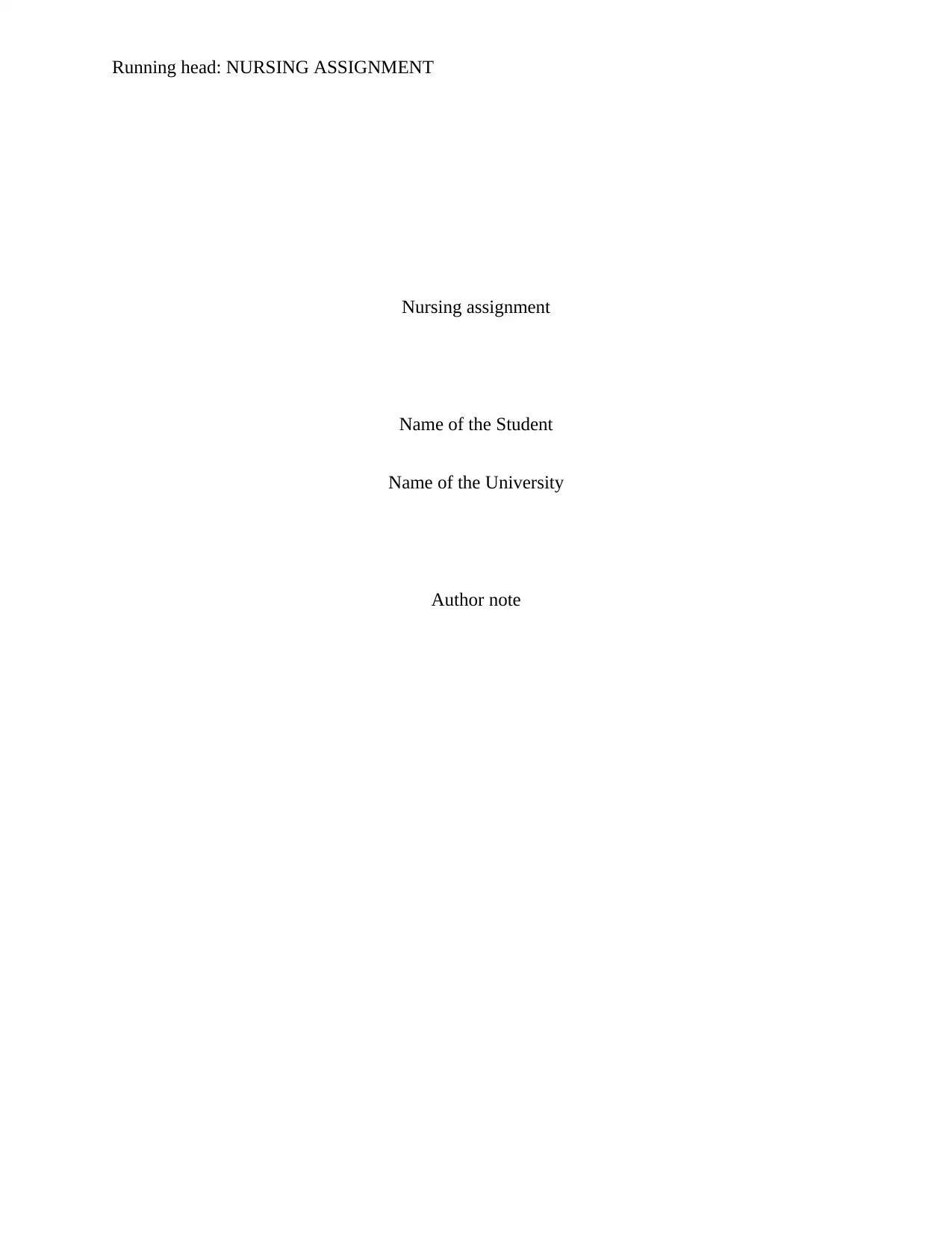
Running head: NURSING ASSIGNMENT
Nursing assignment
Name of the Student
Name of the University
Author note
Nursing assignment
Name of the Student
Name of the University
Author note
Paraphrase This Document
Need a fresh take? Get an instant paraphrase of this document with our AI Paraphraser
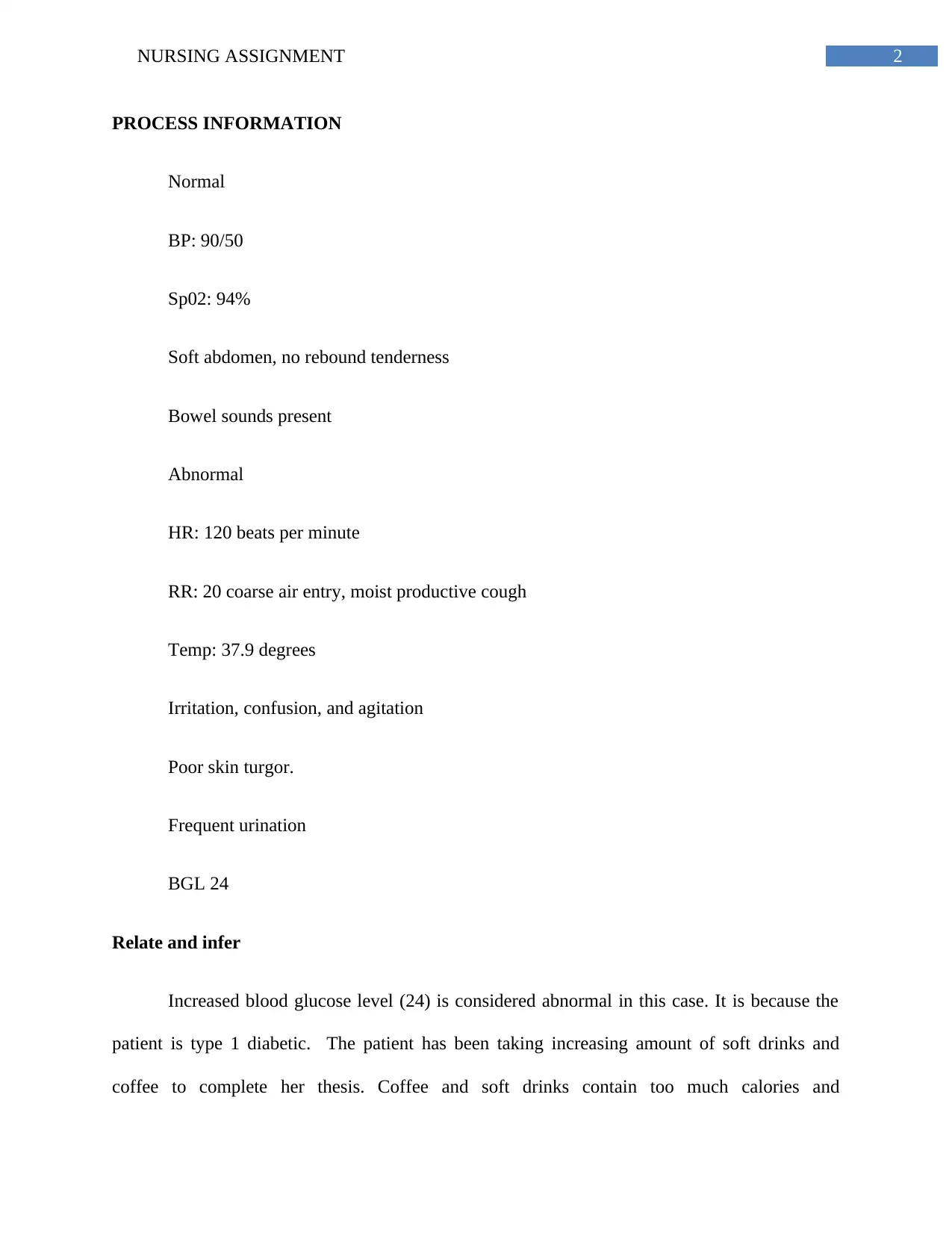
2NURSING ASSIGNMENT
PROCESS INFORMATION
Normal
BP: 90/50
Sp02: 94%
Soft abdomen, no rebound tenderness
Bowel sounds present
Abnormal
HR: 120 beats per minute
RR: 20 coarse air entry, moist productive cough
Temp: 37.9 degrees
Irritation, confusion, and agitation
Poor skin turgor.
Frequent urination
BGL 24
Relate and infer
Increased blood glucose level (24) is considered abnormal in this case. It is because the
patient is type 1 diabetic. The patient has been taking increasing amount of soft drinks and
coffee to complete her thesis. Coffee and soft drinks contain too much calories and
PROCESS INFORMATION
Normal
BP: 90/50
Sp02: 94%
Soft abdomen, no rebound tenderness
Bowel sounds present
Abnormal
HR: 120 beats per minute
RR: 20 coarse air entry, moist productive cough
Temp: 37.9 degrees
Irritation, confusion, and agitation
Poor skin turgor.
Frequent urination
BGL 24
Relate and infer
Increased blood glucose level (24) is considered abnormal in this case. It is because the
patient is type 1 diabetic. The patient has been taking increasing amount of soft drinks and
coffee to complete her thesis. Coffee and soft drinks contain too much calories and
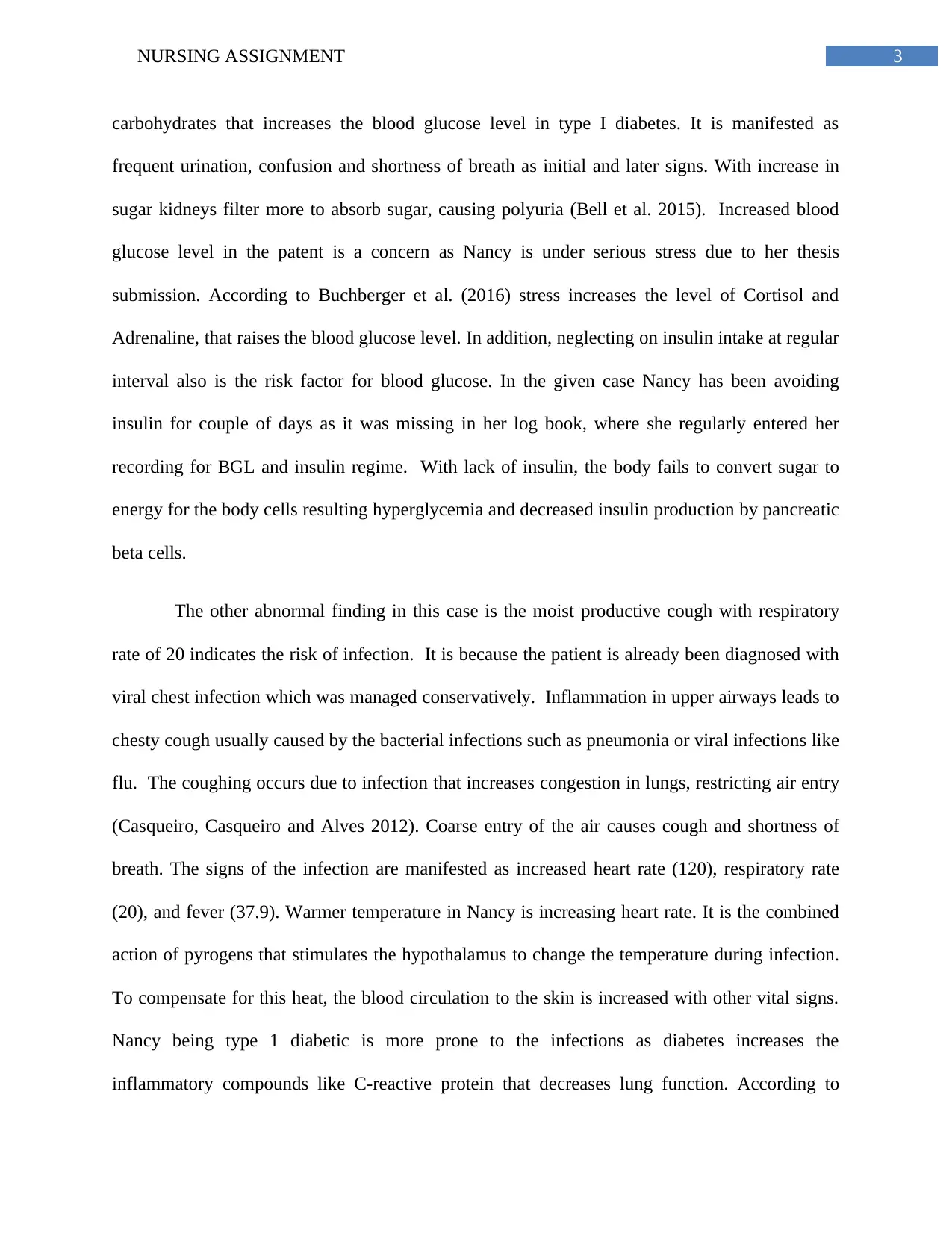
3NURSING ASSIGNMENT
carbohydrates that increases the blood glucose level in type I diabetes. It is manifested as
frequent urination, confusion and shortness of breath as initial and later signs. With increase in
sugar kidneys filter more to absorb sugar, causing polyuria (Bell et al. 2015). Increased blood
glucose level in the patent is a concern as Nancy is under serious stress due to her thesis
submission. According to Buchberger et al. (2016) stress increases the level of Cortisol and
Adrenaline, that raises the blood glucose level. In addition, neglecting on insulin intake at regular
interval also is the risk factor for blood glucose. In the given case Nancy has been avoiding
insulin for couple of days as it was missing in her log book, where she regularly entered her
recording for BGL and insulin regime. With lack of insulin, the body fails to convert sugar to
energy for the body cells resulting hyperglycemia and decreased insulin production by pancreatic
beta cells.
The other abnormal finding in this case is the moist productive cough with respiratory
rate of 20 indicates the risk of infection. It is because the patient is already been diagnosed with
viral chest infection which was managed conservatively. Inflammation in upper airways leads to
chesty cough usually caused by the bacterial infections such as pneumonia or viral infections like
flu. The coughing occurs due to infection that increases congestion in lungs, restricting air entry
(Casqueiro, Casqueiro and Alves 2012). Coarse entry of the air causes cough and shortness of
breath. The signs of the infection are manifested as increased heart rate (120), respiratory rate
(20), and fever (37.9). Warmer temperature in Nancy is increasing heart rate. It is the combined
action of pyrogens that stimulates the hypothalamus to change the temperature during infection.
To compensate for this heat, the blood circulation to the skin is increased with other vital signs.
Nancy being type 1 diabetic is more prone to the infections as diabetes increases the
inflammatory compounds like C-reactive protein that decreases lung function. According to
carbohydrates that increases the blood glucose level in type I diabetes. It is manifested as
frequent urination, confusion and shortness of breath as initial and later signs. With increase in
sugar kidneys filter more to absorb sugar, causing polyuria (Bell et al. 2015). Increased blood
glucose level in the patent is a concern as Nancy is under serious stress due to her thesis
submission. According to Buchberger et al. (2016) stress increases the level of Cortisol and
Adrenaline, that raises the blood glucose level. In addition, neglecting on insulin intake at regular
interval also is the risk factor for blood glucose. In the given case Nancy has been avoiding
insulin for couple of days as it was missing in her log book, where she regularly entered her
recording for BGL and insulin regime. With lack of insulin, the body fails to convert sugar to
energy for the body cells resulting hyperglycemia and decreased insulin production by pancreatic
beta cells.
The other abnormal finding in this case is the moist productive cough with respiratory
rate of 20 indicates the risk of infection. It is because the patient is already been diagnosed with
viral chest infection which was managed conservatively. Inflammation in upper airways leads to
chesty cough usually caused by the bacterial infections such as pneumonia or viral infections like
flu. The coughing occurs due to infection that increases congestion in lungs, restricting air entry
(Casqueiro, Casqueiro and Alves 2012). Coarse entry of the air causes cough and shortness of
breath. The signs of the infection are manifested as increased heart rate (120), respiratory rate
(20), and fever (37.9). Warmer temperature in Nancy is increasing heart rate. It is the combined
action of pyrogens that stimulates the hypothalamus to change the temperature during infection.
To compensate for this heat, the blood circulation to the skin is increased with other vital signs.
Nancy being type 1 diabetic is more prone to the infections as diabetes increases the
inflammatory compounds like C-reactive protein that decreases lung function. According to
⊘ This is a preview!⊘
Do you want full access?
Subscribe today to unlock all pages.

Trusted by 1+ million students worldwide
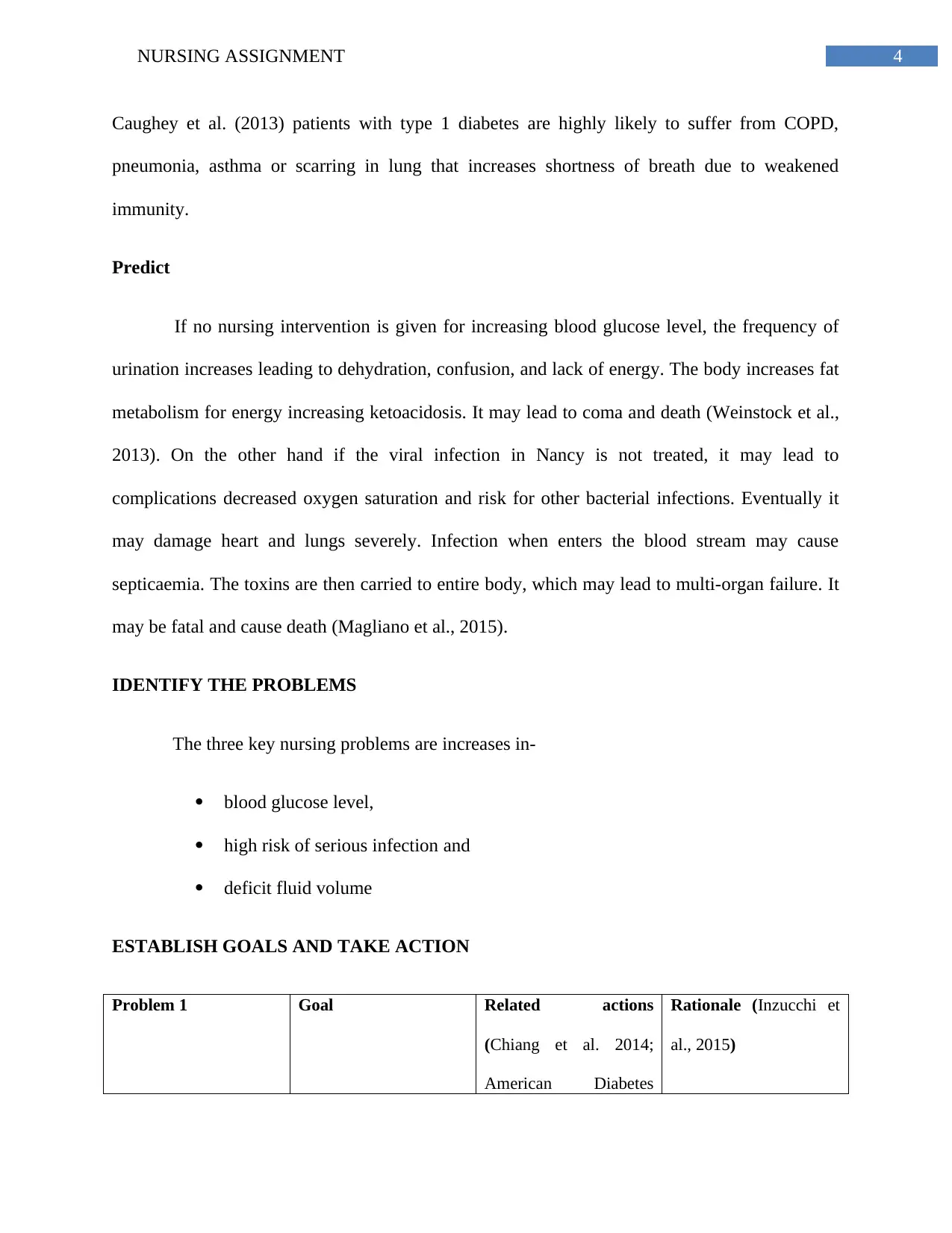
4NURSING ASSIGNMENT
Caughey et al. (2013) patients with type 1 diabetes are highly likely to suffer from COPD,
pneumonia, asthma or scarring in lung that increases shortness of breath due to weakened
immunity.
Predict
If no nursing intervention is given for increasing blood glucose level, the frequency of
urination increases leading to dehydration, confusion, and lack of energy. The body increases fat
metabolism for energy increasing ketoacidosis. It may lead to coma and death (Weinstock et al.,
2013). On the other hand if the viral infection in Nancy is not treated, it may lead to
complications decreased oxygen saturation and risk for other bacterial infections. Eventually it
may damage heart and lungs severely. Infection when enters the blood stream may cause
septicaemia. The toxins are then carried to entire body, which may lead to multi-organ failure. It
may be fatal and cause death (Magliano et al., 2015).
IDENTIFY THE PROBLEMS
The three key nursing problems are increases in-
blood glucose level,
high risk of serious infection and
deficit fluid volume
ESTABLISH GOALS AND TAKE ACTION
Problem 1 Goal Related actions
(Chiang et al. 2014;
American Diabetes
Rationale (Inzucchi et
al., 2015)
Caughey et al. (2013) patients with type 1 diabetes are highly likely to suffer from COPD,
pneumonia, asthma or scarring in lung that increases shortness of breath due to weakened
immunity.
Predict
If no nursing intervention is given for increasing blood glucose level, the frequency of
urination increases leading to dehydration, confusion, and lack of energy. The body increases fat
metabolism for energy increasing ketoacidosis. It may lead to coma and death (Weinstock et al.,
2013). On the other hand if the viral infection in Nancy is not treated, it may lead to
complications decreased oxygen saturation and risk for other bacterial infections. Eventually it
may damage heart and lungs severely. Infection when enters the blood stream may cause
septicaemia. The toxins are then carried to entire body, which may lead to multi-organ failure. It
may be fatal and cause death (Magliano et al., 2015).
IDENTIFY THE PROBLEMS
The three key nursing problems are increases in-
blood glucose level,
high risk of serious infection and
deficit fluid volume
ESTABLISH GOALS AND TAKE ACTION
Problem 1 Goal Related actions
(Chiang et al. 2014;
American Diabetes
Rationale (Inzucchi et
al., 2015)
Paraphrase This Document
Need a fresh take? Get an instant paraphrase of this document with our AI Paraphraser
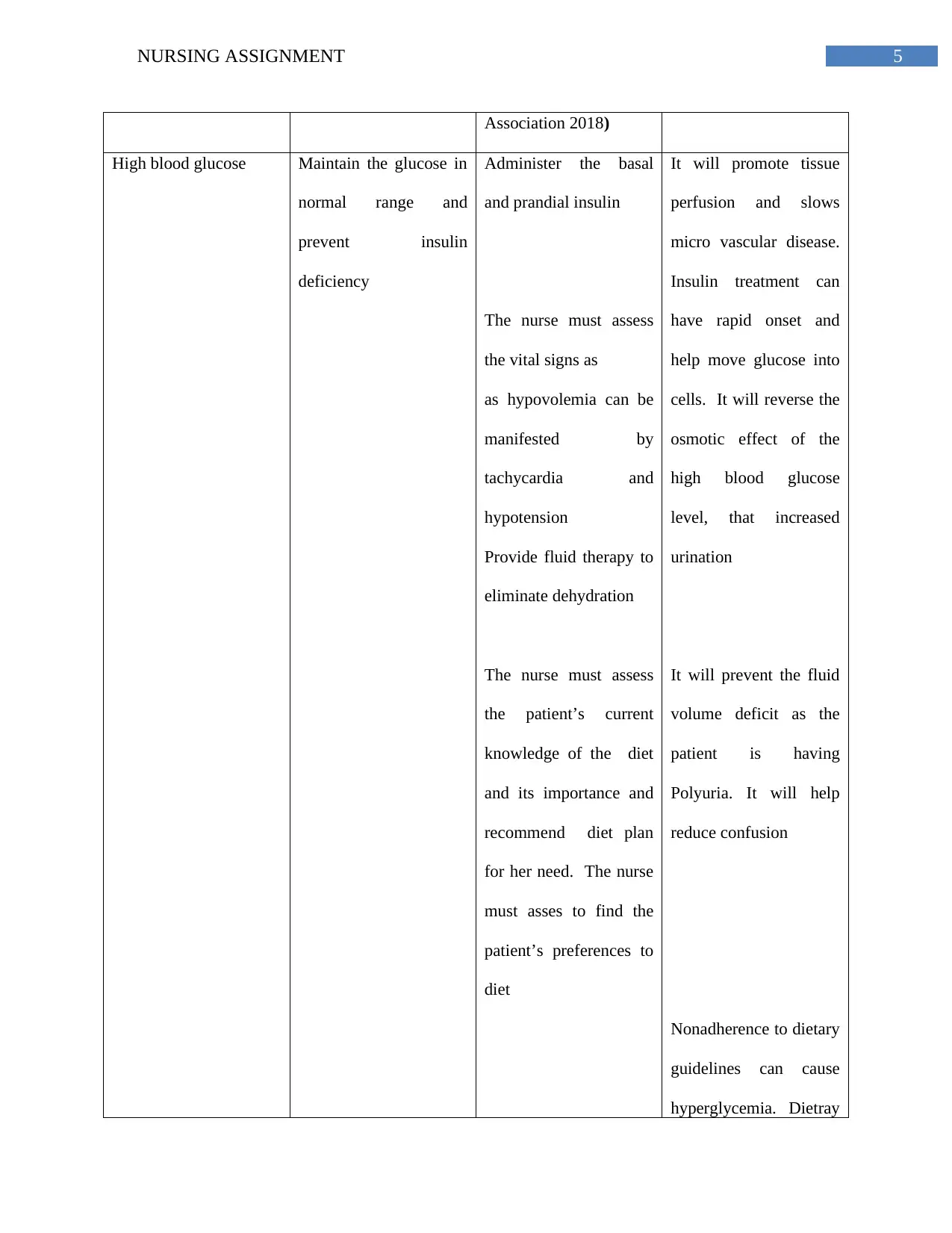
5NURSING ASSIGNMENT
Association 2018)
High blood glucose Maintain the glucose in
normal range and
prevent insulin
deficiency
Administer the basal
and prandial insulin
The nurse must assess
the vital signs as
as hypovolemia can be
manifested by
tachycardia and
hypotension
Provide fluid therapy to
eliminate dehydration
The nurse must assess
the patient’s current
knowledge of the diet
and its importance and
recommend diet plan
for her need. The nurse
must asses to find the
patient’s preferences to
diet
It will promote tissue
perfusion and slows
micro vascular disease.
Insulin treatment can
have rapid onset and
help move glucose into
cells. It will reverse the
osmotic effect of the
high blood glucose
level, that increased
urination
It will prevent the fluid
volume deficit as the
patient is having
Polyuria. It will help
reduce confusion
Nonadherence to dietary
guidelines can cause
hyperglycemia. Dietray
Association 2018)
High blood glucose Maintain the glucose in
normal range and
prevent insulin
deficiency
Administer the basal
and prandial insulin
The nurse must assess
the vital signs as
as hypovolemia can be
manifested by
tachycardia and
hypotension
Provide fluid therapy to
eliminate dehydration
The nurse must assess
the patient’s current
knowledge of the diet
and its importance and
recommend diet plan
for her need. The nurse
must asses to find the
patient’s preferences to
diet
It will promote tissue
perfusion and slows
micro vascular disease.
Insulin treatment can
have rapid onset and
help move glucose into
cells. It will reverse the
osmotic effect of the
high blood glucose
level, that increased
urination
It will prevent the fluid
volume deficit as the
patient is having
Polyuria. It will help
reduce confusion
Nonadherence to dietary
guidelines can cause
hyperglycemia. Dietray
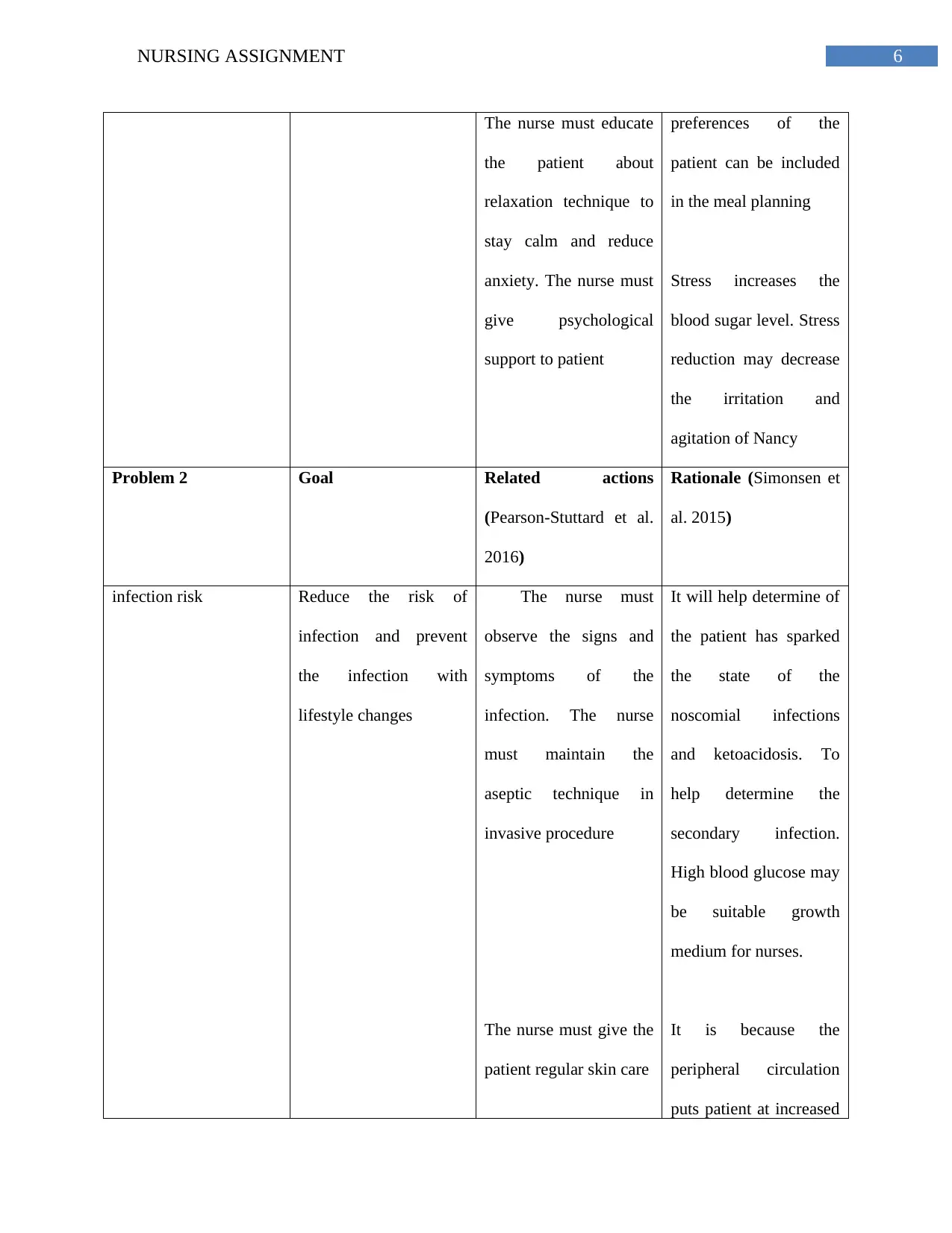
6NURSING ASSIGNMENT
The nurse must educate
the patient about
relaxation technique to
stay calm and reduce
anxiety. The nurse must
give psychological
support to patient
preferences of the
patient can be included
in the meal planning
Stress increases the
blood sugar level. Stress
reduction may decrease
the irritation and
agitation of Nancy
Problem 2 Goal Related actions
(Pearson-Stuttard et al.
2016)
Rationale (Simonsen et
al. 2015)
infection risk Reduce the risk of
infection and prevent
the infection with
lifestyle changes
The nurse must
observe the signs and
symptoms of the
infection. The nurse
must maintain the
aseptic technique in
invasive procedure
The nurse must give the
patient regular skin care
It will help determine of
the patient has sparked
the state of the
noscomial infections
and ketoacidosis. To
help determine the
secondary infection.
High blood glucose may
be suitable growth
medium for nurses.
It is because the
peripheral circulation
puts patient at increased
The nurse must educate
the patient about
relaxation technique to
stay calm and reduce
anxiety. The nurse must
give psychological
support to patient
preferences of the
patient can be included
in the meal planning
Stress increases the
blood sugar level. Stress
reduction may decrease
the irritation and
agitation of Nancy
Problem 2 Goal Related actions
(Pearson-Stuttard et al.
2016)
Rationale (Simonsen et
al. 2015)
infection risk Reduce the risk of
infection and prevent
the infection with
lifestyle changes
The nurse must
observe the signs and
symptoms of the
infection. The nurse
must maintain the
aseptic technique in
invasive procedure
The nurse must give the
patient regular skin care
It will help determine of
the patient has sparked
the state of the
noscomial infections
and ketoacidosis. To
help determine the
secondary infection.
High blood glucose may
be suitable growth
medium for nurses.
It is because the
peripheral circulation
puts patient at increased
⊘ This is a preview!⊘
Do you want full access?
Subscribe today to unlock all pages.

Trusted by 1+ million students worldwide
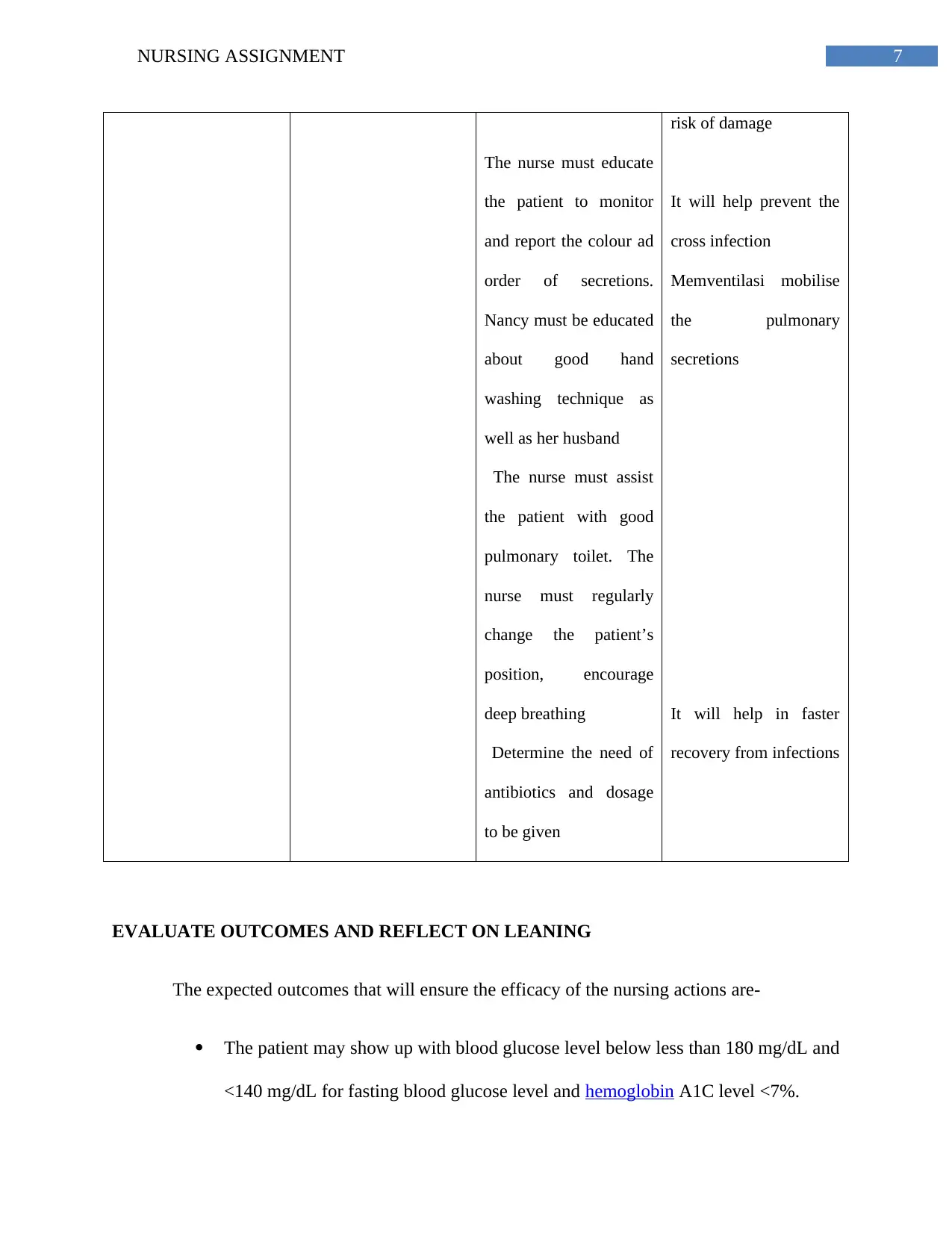
7NURSING ASSIGNMENT
The nurse must educate
the patient to monitor
and report the colour ad
order of secretions.
Nancy must be educated
about good hand
washing technique as
well as her husband
The nurse must assist
the patient with good
pulmonary toilet. The
nurse must regularly
change the patient’s
position, encourage
deep breathing
Determine the need of
antibiotics and dosage
to be given
risk of damage
It will help prevent the
cross infection
Memventilasi mobilise
the pulmonary
secretions
It will help in faster
recovery from infections
EVALUATE OUTCOMES AND REFLECT ON LEANING
The expected outcomes that will ensure the efficacy of the nursing actions are-
The patient may show up with blood glucose level below less than 180 mg/dL and
<140 mg/dL for fasting blood glucose level and hemoglobin A1C level <7%.
The nurse must educate
the patient to monitor
and report the colour ad
order of secretions.
Nancy must be educated
about good hand
washing technique as
well as her husband
The nurse must assist
the patient with good
pulmonary toilet. The
nurse must regularly
change the patient’s
position, encourage
deep breathing
Determine the need of
antibiotics and dosage
to be given
risk of damage
It will help prevent the
cross infection
Memventilasi mobilise
the pulmonary
secretions
It will help in faster
recovery from infections
EVALUATE OUTCOMES AND REFLECT ON LEANING
The expected outcomes that will ensure the efficacy of the nursing actions are-
The patient may show up with blood glucose level below less than 180 mg/dL and
<140 mg/dL for fasting blood glucose level and hemoglobin A1C level <7%.
Paraphrase This Document
Need a fresh take? Get an instant paraphrase of this document with our AI Paraphraser
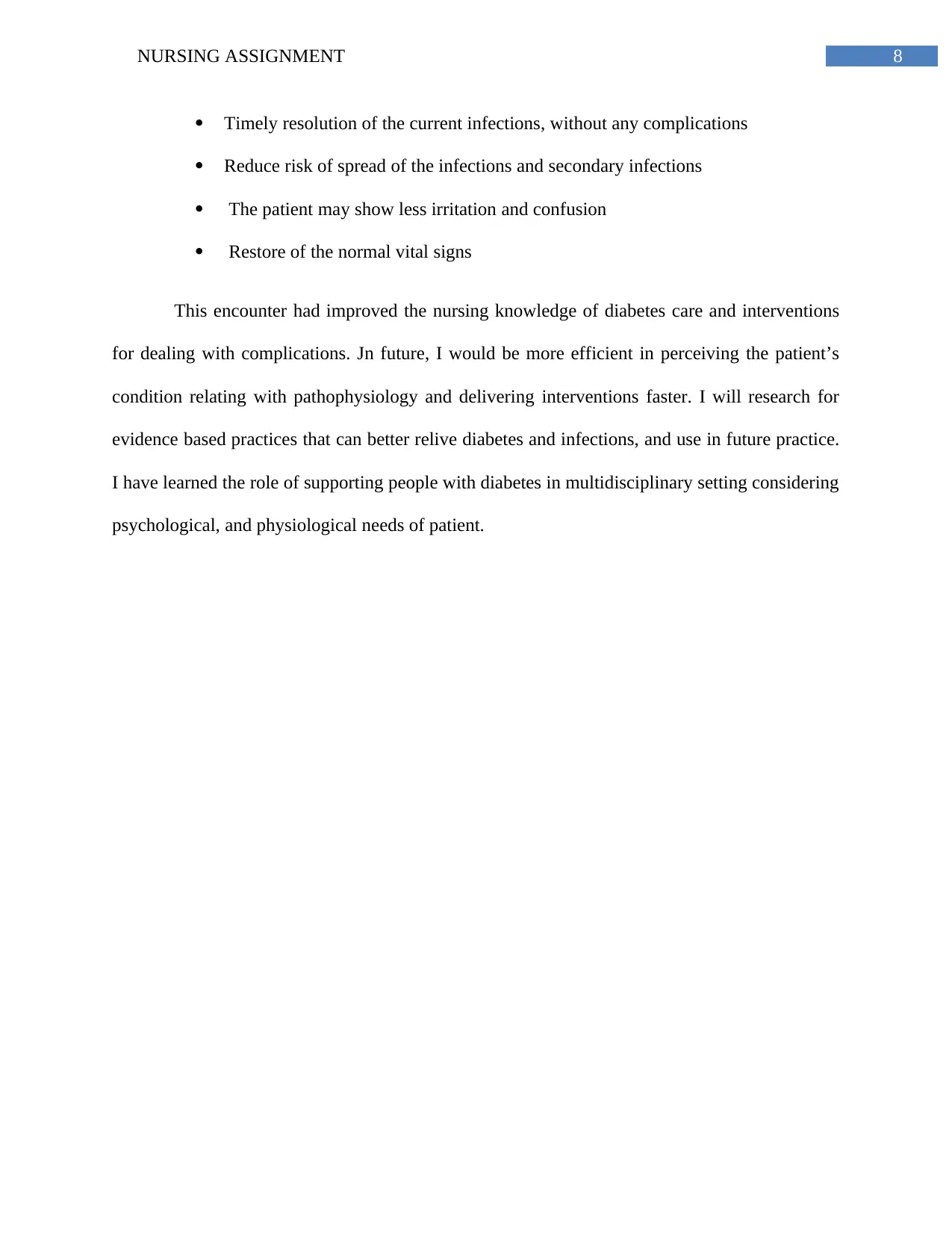
8NURSING ASSIGNMENT
Timely resolution of the current infections, without any complications
Reduce risk of spread of the infections and secondary infections
The patient may show less irritation and confusion
Restore of the normal vital signs
This encounter had improved the nursing knowledge of diabetes care and interventions
for dealing with complications. Jn future, I would be more efficient in perceiving the patient’s
condition relating with pathophysiology and delivering interventions faster. I will research for
evidence based practices that can better relive diabetes and infections, and use in future practice.
I have learned the role of supporting people with diabetes in multidisciplinary setting considering
psychological, and physiological needs of patient.
Timely resolution of the current infections, without any complications
Reduce risk of spread of the infections and secondary infections
The patient may show less irritation and confusion
Restore of the normal vital signs
This encounter had improved the nursing knowledge of diabetes care and interventions
for dealing with complications. Jn future, I would be more efficient in perceiving the patient’s
condition relating with pathophysiology and delivering interventions faster. I will research for
evidence based practices that can better relive diabetes and infections, and use in future practice.
I have learned the role of supporting people with diabetes in multidisciplinary setting considering
psychological, and physiological needs of patient.
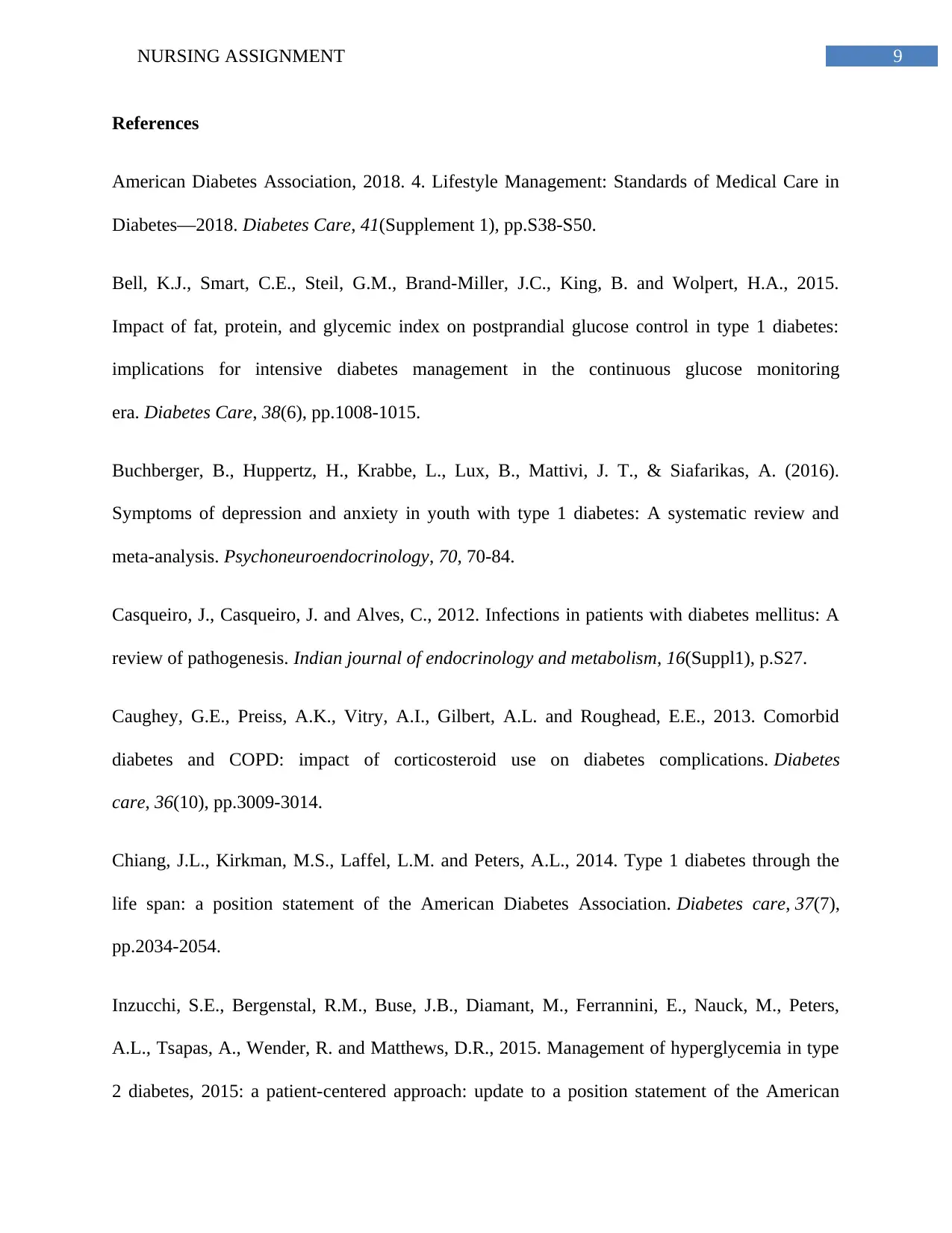
9NURSING ASSIGNMENT
References
American Diabetes Association, 2018. 4. Lifestyle Management: Standards of Medical Care in
Diabetes—2018. Diabetes Care, 41(Supplement 1), pp.S38-S50.
Bell, K.J., Smart, C.E., Steil, G.M., Brand-Miller, J.C., King, B. and Wolpert, H.A., 2015.
Impact of fat, protein, and glycemic index on postprandial glucose control in type 1 diabetes:
implications for intensive diabetes management in the continuous glucose monitoring
era. Diabetes Care, 38(6), pp.1008-1015.
Buchberger, B., Huppertz, H., Krabbe, L., Lux, B., Mattivi, J. T., & Siafarikas, A. (2016).
Symptoms of depression and anxiety in youth with type 1 diabetes: A systematic review and
meta-analysis. Psychoneuroendocrinology, 70, 70-84.
Casqueiro, J., Casqueiro, J. and Alves, C., 2012. Infections in patients with diabetes mellitus: A
review of pathogenesis. Indian journal of endocrinology and metabolism, 16(Suppl1), p.S27.
Caughey, G.E., Preiss, A.K., Vitry, A.I., Gilbert, A.L. and Roughead, E.E., 2013. Comorbid
diabetes and COPD: impact of corticosteroid use on diabetes complications. Diabetes
care, 36(10), pp.3009-3014.
Chiang, J.L., Kirkman, M.S., Laffel, L.M. and Peters, A.L., 2014. Type 1 diabetes through the
life span: a position statement of the American Diabetes Association. Diabetes care, 37(7),
pp.2034-2054.
Inzucchi, S.E., Bergenstal, R.M., Buse, J.B., Diamant, M., Ferrannini, E., Nauck, M., Peters,
A.L., Tsapas, A., Wender, R. and Matthews, D.R., 2015. Management of hyperglycemia in type
2 diabetes, 2015: a patient-centered approach: update to a position statement of the American
References
American Diabetes Association, 2018. 4. Lifestyle Management: Standards of Medical Care in
Diabetes—2018. Diabetes Care, 41(Supplement 1), pp.S38-S50.
Bell, K.J., Smart, C.E., Steil, G.M., Brand-Miller, J.C., King, B. and Wolpert, H.A., 2015.
Impact of fat, protein, and glycemic index on postprandial glucose control in type 1 diabetes:
implications for intensive diabetes management in the continuous glucose monitoring
era. Diabetes Care, 38(6), pp.1008-1015.
Buchberger, B., Huppertz, H., Krabbe, L., Lux, B., Mattivi, J. T., & Siafarikas, A. (2016).
Symptoms of depression and anxiety in youth with type 1 diabetes: A systematic review and
meta-analysis. Psychoneuroendocrinology, 70, 70-84.
Casqueiro, J., Casqueiro, J. and Alves, C., 2012. Infections in patients with diabetes mellitus: A
review of pathogenesis. Indian journal of endocrinology and metabolism, 16(Suppl1), p.S27.
Caughey, G.E., Preiss, A.K., Vitry, A.I., Gilbert, A.L. and Roughead, E.E., 2013. Comorbid
diabetes and COPD: impact of corticosteroid use on diabetes complications. Diabetes
care, 36(10), pp.3009-3014.
Chiang, J.L., Kirkman, M.S., Laffel, L.M. and Peters, A.L., 2014. Type 1 diabetes through the
life span: a position statement of the American Diabetes Association. Diabetes care, 37(7),
pp.2034-2054.
Inzucchi, S.E., Bergenstal, R.M., Buse, J.B., Diamant, M., Ferrannini, E., Nauck, M., Peters,
A.L., Tsapas, A., Wender, R. and Matthews, D.R., 2015. Management of hyperglycemia in type
2 diabetes, 2015: a patient-centered approach: update to a position statement of the American
⊘ This is a preview!⊘
Do you want full access?
Subscribe today to unlock all pages.

Trusted by 1+ million students worldwide
1 out of 9
Related Documents
Your All-in-One AI-Powered Toolkit for Academic Success.
+13062052269
info@desklib.com
Available 24*7 on WhatsApp / Email
![[object Object]](/_next/static/media/star-bottom.7253800d.svg)
Unlock your academic potential
Copyright © 2020–2025 A2Z Services. All Rights Reserved. Developed and managed by ZUCOL.





